The 5 Key Elements of Trust

Can you build trust systematically?
It is Sunday February 14th, 2021, Valentine’s Day in Austin, Texas. As the arctic freeze dumps a foot of snow and a global pandemic rages on, I asked my wife what she thought about trust.
“To trust people they have to be dependable.”
I responded with a question I have been thinking about for the past 5 years, “Can you systematically build trust like a process?”
“No. It is organic.” she responded confidently.
I politely attempted to make my case. First a little context, we started JUST with a belief that we can leverage the trust already present in low-income communities to invest in ambitious women excluded from economic opportunity. The formal financial system in the United States is designed to analyze people’s past to predict future risk.
If you are poor, this is not a system that builds trust. Formal finance is designed to mitigate risk. It is not designed to hope people can do better.
Inspired by global microfinance and group lending, JUST has reimagined trust-based or character-based lending for the United States. We have understood the importance of money for entrepreneurs and the principles of social capital to ensure high repayments. Yet, we believed there could be a more efficient and effective process to trust people. We have discovered a new model that is tech-enabled, led by the community, and leading to better outcomes.
At the inception of JUST, we made trust a core value. We believe trust is a two-way street that is the responsibility of both sides. We see trust as a system that must be managed and measured.
The five key elements
There are five key elements of trust that drive our philosophy:
- Reliability: Being reliable creates trust.
- Honesty: Telling the truth creates trust.
- Good Will: Acting in good faith creates trust.
- Competency: Doing your job well creates trust.
- Open: Being vulnerable creates trust.
To be clear, JUST can improve significantly in each one of these areas. We are committed to the journey of improvement alongside our clients. Trust grows over time. At the beginning of the pandemic, we saw first-hand the power and potential of trust.
The ultimate test
When shelter-in-place orders stopped all business activities in March, we worried deeply about our clients’ livelihoods. We took immediate action to pause all loan repayments indefinitely. At the same time, we knew an extra $1,000 could be a big help for many of our clients. We weren’t sure how many of our 800 clients would need cash and also not sure where JUST would find the money for such a risky product.
We decided to launch an emergency loan of $1,000 that included an indefinite grace period and no interest. We debated as a team how to share our plan with clients. There were two schools of thought.
- Only tell a few clients when we knew for certain that we could make good on our promise to extend emergency loans.
- Announce our plans to the entire community at once. Have them sign up and be transparent that we might not be able to serve everyone. Our biggest worry with this option was that people would remain on the waiting list indefinitely and lose hope.
Time to make a decision
Through open internal debate, we decided that our philosophy on trust would guide our decision. We saw the second option gave us a much greater opportunity to build trust. The greatest risk was our ability to execute.
The good news is that we did execute. A total of 472 clients requested a loan and we were able to raise enough money so no one had to wait. As of today, our clients have repaid over 95% of these loans.
This emergency loan experience has built even more trust with our clients and our team. We showed our clients they could count on us.
The lesson
We learned that being honest helped strengthen our relationships. Our commitment to our clients during their most trying times created more good will. We tested our team’s competence and proved we could accomplish more than we thought.
Finally, by being open as a team to debate and extending that vulnerability to our clients, we have strengthened our relationships.
Look for examples in your own life for people you trust and don’t trust. These five elements will continue to show up. If we see trust as a system, it then becomes something we can exercise like a muscle.
At the beginning, trust is fragile. With intentional effort, it gets stronger and grows over time.
To build trust, we have to continue to show up and deliver on our promises, just like a good marriage. To my surprise, my wife said, “Ok, you have me convinced.”

